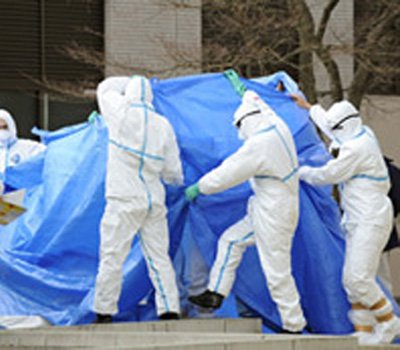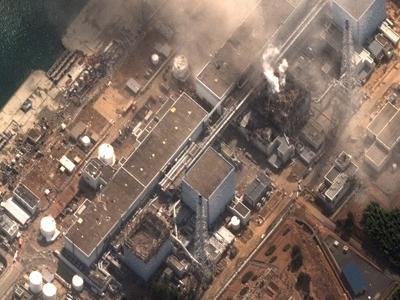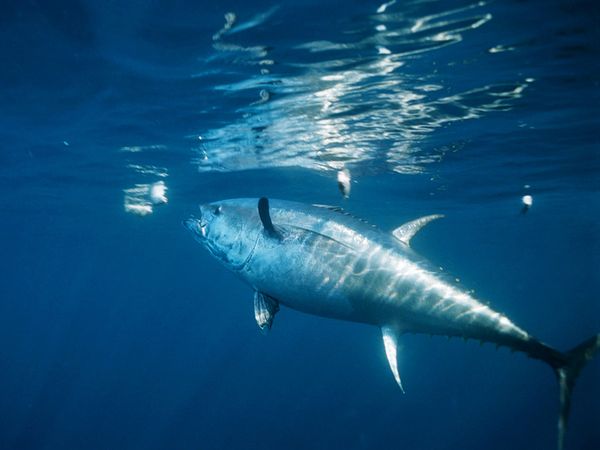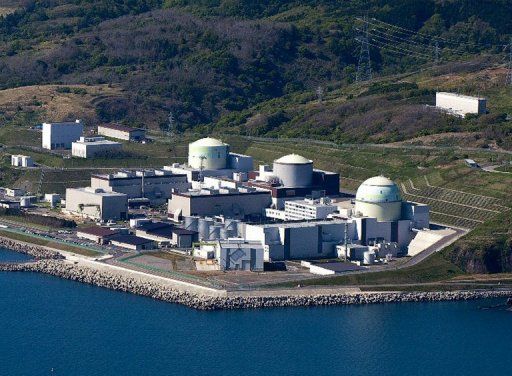Home Tags Posts tagged with "Fukushima"
Fukushima
Japan will investigate a report that workers at the stricken Fukushima Daiichi nuclear power plant were urged to disguise their exposure to radiation.
Build-Up, a subcontractor for plant operator Tepco, admitted one of its executives told workers to put lead shields on radiation detection devices.
Otherwise, they would have rapidly exceeded the legal limit for exposure.
The Fukishima plant was devastated by the March 2011 earthquake and tsunami.
Cooling systems to reactors were knocked out, leading to meltdowns and the release of radioactivity.
Tens of thousands of residents were evacuated from an exclusion zone around the plant.

Build-Up, a subcontractor for plant operator Tepco, admitted one of its executives told workers to put lead shields on radiation detection devices
Between November and March this year, a group of Build-Up employees were working at Fukushima, trying to restore facilities.
In December, a Build-Up executive told them to cover their dosimeters with lead casings when working in areas with high radiation.
Otherwise, he warned, they would quickly reach the legal limit of 50 millisieverts’ exposure in a year, and they would have to stop working.
Build-Up president Takashi Wada told Japanese media nine of the workers complied.
Dosimeters – used to measure cumulative exposure – can be worn as badges or carried as devices about the size of a smartphone.
The workers had a recording of their meeting, the Asahi Shimbun newspaper said.
“Unless we hide it with lead, exposure will max out and we cannot work,” the executive was heard saying in the recording, as quoted by the paper.
The executive apparently said he used one of the lead shields himself.
A Tepco spokesman told Reuters on Saturday the company was aware from a separate contractor that Build-Up made the lead shields, but that they were never used at the Fukushima plant.
Earlier this month, a Japanese parliamentary panel concluded the disaster at Fukushima was “profoundly manmade” and its effects could have been “mitigated by a more effective human response”.
All of Japan’s nuclear plants were shut down in the wake of the disaster but one, in the town of Ohi, has now partially restarted.
Fukushima disaster:
• Reactor cooling systems damaged after 11 March earthquake and tsunami
• Explosions occurred on 12-15 March at four reactors after gas build-up
• Tepco engineers injected seawater into reactors for cooling
• Contaminated waste-water leaked on several occasions
• Meltdowns later confirmed at three reactors
• Tepco declared ‘cold shutdown’ – meaning reactors were stable – in December 2011
A Japanese parliamentary panel has said in a report the crisis at the Fukushima nuclear plant was “a profoundly man-made disaster”.
The disaster “could and should have been foreseen and prevented” and its effects “mitigated by a more effective human response”, it said.
The report catalogued serious deficiencies in both the government and plant operator Tepco’s response.
It also blamed cultural conventions and a reluctance to question authority.
The six-reactor Fukushima Daiichi nuclear plant was badly damaged after the 11 March 2011 earthquake and tsunami knocked out cooling systems to reactors, leading to meltdowns and the release of radioactivity.
Tens of thousands of residents were evacuated from an exclusion zone around the plant as workers battled to bring reactors under control. Tepco declared the reactors stable in December 2011.
Members of the Fukushima Nuclear Accident Independent Investigation Commission were appointed to examine the handling of the crisis and make recommendations.
The investigation included 900 hours of hearings and interviews with more than 1,000 people.

A Japanese parliamentary panel has said in a report the crisis at the Fukushima nuclear plant was "a profoundly man-made disaster
In the panel’s final report, its chairman said a multitude of errors and willful negligence had left the plant unprepared for the earthquake and tsunami.
“Although triggered by these cataclysmic events, the subsequent accident at the Fukushima Daiichi Nuclear Power Plant cannot be regarded as a natural disaster,” it said.
“It was a profoundly man-made disaster – that could and should have been foreseen and prevented.”
After six months of investigation, the panel concluded that the disaster “was the result of collusion between the government, the regulators and Tepco” founded in the failure of regulatory systems.
It said that the situation at the plant worsened in the aftermath of the earthquake because government agencies “did not function correctly”, with key roles left ambiguous.
It also highlighted communication failures between Tepco and the office of then Prime Minister Naoto Kan, whose visit to the site in the immediate aftermath of the earthquake “diverted” staff.
The report said regulators should “go through an essential transformation process” to ensure nuclear safety in Japan.
“Japan’s regulators need to shed the insular attitude of ignoring international safety standards and transform themselves into a globally trusted entity,” it said.
The report made several recommendations including:
• Permanent parliamentary monitoring of the nuclear regulatory body
• Reforming the crisis management system, with more government responsibility for public welfare
• Reforming nuclear energy laws to meet global safety standards
• Monitoring nuclear operators and developing a system for independent investigative bodies
All of Japan’s nuclear plants were shut down in the wake of the disaster. But on Sunday the first reactor was restarted in the town of Ohi in Fukui prefecture.
The restart sparked large protests in Tokyo but Prime Minister Yoshihiko Noda urged support for the move, saying a return to nuclear power was essential for the economy.
The government is continuing to assess whether other nuclear plants are safe to be restarted.
A record radioactive contamination from last year’s Fukushima nuclear accident has been detected in Pacific Bluefin tuna caught off the coast of California.
Bluefin tuna would have picked up the pollution while swimming in Japanese waters, before then moving to the far side of the ocean.
Scientists stress that the fish are still perfectly safe to eat.
However, the case does illustrate how migratory species can carry pollution over vast distances, they say.
“It’s a lesson to us in how interconnected eco-regions can be, even when they may be separated by thousands of miles,” said Nicholas Fisher, a professor of marine sciences at Stony Brook University, New York.
Fisher and colleagues report their study in the journal Proceedings of the National Academy of Sciences.

A record radioactive contamination from last year's Fukushima nuclear accident has been detected in Pacific Bluefin tuna caught off the coast of California
They examined the muscle tissues of 15 Bluefin tuna (Thunnus orientalis) taken from waters off San Diego in August 2011, just a few months after the accident at the Fukushima Daiichi nuclear plant.
These were animals whose parents would have spawned in Japanese waters and spent one to two years locally before heading to feeding grounds in the eastern Pacific.
All the fish examined in the study showed elevated levels of radioactive caesium – the isotopes 134 and 137.
Caesium-137 is present in seawater anyway as a result of the fallout from atomic weapons testing, but the short, two-year half-life of caesium-134 means the contamination can be tied directly to Fukushima. There is no other explanation for the isotope’s presence.
The measured concentrations were about 10 times the total caesium radioactivity seen in tuna specimens taken from before the accident.
As a control, the team also examined Yellowfin tuna, which are largely residential in the eastern Pacific.
These animals showed no difference in their pre- or post-Fukushima concentrations.
The research is likely to get attention because Bluefin tuna is an iconic species and a highly valuable fishery – thousands of tons are landed annually.
But consumers should have no health concerns about eating California-caught tuna from last year, the team says.
The levels of radioactivity are well within permitted limits, and below those from other radioisotopes that occur naturally in the environment, such as potassium-40.
“The potassium was about 30 times higher than the combined radio-caesium levels. If you calculate how much additional radioactivity there is in the Pacific Bluefin tuna caught in California relative to the natural background – it’s about 3%,” said Prof. Nicholas Fisher.
The scientists even calculated how much radioactivity might have been present in the fish before they swam across the Pacific (it would have fallen over time) and figured it could have been 50% above background levels; but, again, this would still have met the legal requirements for safe consumption.
Tuna caught in the coming months will be subjected to new tests. These animals would have spent much longer in Japanese waters and so conceivably could have a very different pollution load.
The team also believes the investigation should be extended to other migratory species that frequent Japanese waters.
Fukushima pollution is potentially a very useful tool to trace the origin and timing of animal movements. The ratio of caesium 134 to 137 could be used like a clock to work out when and how long a particular migration took.
“This information might be useful in conservation efforts or in managing fisheries,” said Prof. Nicholas Fisher.
Japan has decided to switch off its last working nuclear reactor, as part of the safety drive since the March 2011 tsunami triggered a meltdown at the Fukushima plant.
The third reactor at the Tomari plant, in Hokkaido prefecture, is shutting down for routine maintenance.
The move leaves Japan without energy from atomic power for the first time for more than 40 years.
Until last year, Japan got 30% of its power from nuclear energy.
Hundreds of people marched through Tokyo, waving banners to celebrate what they hope will be the end of nuclear power in Japan.
Since the Fukushima disaster, all Japan’s reactors have been shut down for routine maintenance. They must withstand tests against earthquakes and tsunamis, and local authorities must give their consent in order for plants to restart.
So far, none have.

The third reactor at the Tomari plant, in Hokkaido prefecture, is shutting down for routine maintenance
Two reactors at the Ohi plant in western Japan have been declared safe. The government says they should be restarted to combat looming shortages.
However, regional authorities would still have to give their approval.
Ministers have warned Japan faces a summer of power shortages.
The government could force the issue, but so far has been reluctant to move against public opinion.
Organizers of the anti-nuclear march in the capital estimated turnout at 5,500.
Demonstrators carried banners shaped as giant fish. The “Koinobori” banners, traditionally the symbol of Children’s Day, have been adopted by the anti-nuclear movement.
“There are so many nuclear plants, but not a single one will be up and running today, and that’s because of our efforts,” campaigner Masashi Ishikawa told the crowd.
Engineers began the process of shutting down the final Tomari reactor, inserting control rods to bring the fission process to an end.
All operations at the plant will have stopped by 14:00 GMT, a spokesman told Associated Press.
Japan will then be without nuclear power for the first time since 1970.
Businesses have warned of severe consequences for manufacturing if no nuclear plants are allowed to re-start.
In the meantime, Japan has increased its fossil fuel imports, with electricity companies pressing old power plants into service.
If the country can get through the steamy summer without blackouts, calls to make the nuclear shutdown permanent will get louder.
The six-reactor Fukushima Daiichi nuclear plant was badly damaged by the March 2011 earthquake and tsunami.
Blasts occurred at four of the reactors after the cooling systems went offline, triggering radiation leaks and forcing the evacuation of thousands of people.
A 20 km (12 miles) exclusion zone remains in place around the plant.
Nicolas Sarkozy has admitted he did not visit Fukushima on a visit to Japan after last year’s tsunami, despite saying he had.
Election rival Francois Hollande had queried Nicolas Sarkozy’s claim that he had been to the stricken nuclear plant.
French president admitted on Friday that he had not. “I’m not an engineer, I don’t need to stick my nose in the situation at Fukushima,” he said on I-tele.
The future of France’s nuclear power industry has become an election issue.
The Socialists have pledged to reduce France’s dependence on nuclear energy for its electricity, from 75% to 50% by 2025.
Nicolas Sarkozy’s centre-right UMP government argues that the nuclear industry is good for the country economically, generating employment and exports along with clean, reliable electricity.

Nicolas Sarkozy has admitted he did not visit Fukushima on a visit to Japan after last year's tsunami, despite saying he had
The president had told an election rally in Normandy last Friday that he had visited Fukushima with his then ecology minister, Nathalie Kosciusko-Morizet.
Francois Hollande, the Socialist presidential candidate, said on Tuesday that he had checked out Nicolas Sarkozy’s statement and that “he never went there”.
“It’s the first time in the history of the Republic that an outgoing candidate has described a trip he never made,” Francois Hollande said.
“He’ll have been a pioneer in everything. Even on a trip he never took.”
Nicolas Sarkozy acknowledged on I-tele: “I went to Japan with Nathalie Kosciusko-Morizet, I met the Japanese authorities, I discussed with the [Japanese] prime minister the situation at Fukushima and Nathalie Kosciusko-Morizet went there.”
He said that he had been making the point that linking what happened at Fukushima to the debate over a nuclear power plant in France was absurd.
“I simply said that at Fukushima what happened was not a nuclear incident – it was a tsunami, with a wave that reached 42 metres in height that demolished the pumping systems that enabled the cooling of the central core, and that to say as a result of Fukushima that you should shut Fessenheim [nuclear plant] in Alsace, that seemed to me to be a particularly remarkable absurdity.”
It is not the first such gaffe Nicolas Sarkozy has made.
In 2009, he posted on Facebook a picture of himself at the Berlin Wall, saying he had chipped away at it with a pickaxe on the day the wall came down.
A caption dated the photo “9 November 1989”, but the man who took it said it was definitely from the following day.
[youtube ZnlSKZTKyIg]
Prime Minister Yoshihiko Noda has announced that crippled nuclear reactors at Japan’s Fukushima power plant have finally been stabilized.
The earthquake and tsunami in March this year knocked out vital cooling systems, triggering radiation leaks and forcing the evacuation of thousands of people.
Yoshihiko Noda’s declaration of a “cold shutdown” condition marked the stabilization of the plant.
Japanese government says it will take decades to dismantle it completely.
The six-reactor Fukushima Daiichi nuclear plant was badly damaged by the 11 March earthquake and tsunami. Blasts occurred at four of the reactors after the cooling systems went offline.
Workers at the plant, which is operated by Tokyo Electric Power Company (Tepco), have been using sea water to cool the reactors. Waste water has built up and some contaminated liquid has been released into the sea.
A 20 km (12 miles) exclusion zone remains in place around the plant.
“The nuclear reactors have reached a state of cold shutdown and therefore we can now confirm that we have come to the end of the accident phase of the actual reactors,” Yoshihiko Noda told a news conference.
“We are now moving from trying to stabilize the nuclear reactors to decommissioning them.
“The Japanese government promises to clarify the roadmap from here and do our utmost, while ensuring we operate the nuclear reactors as safely as possible, to decommission them.”
The “battle is not over”, PM said, adding that the next phase would focus on the clean-up operation, including decontaminating the ground around the plant.
With the reactors stable, Yoshihiko Noda said the government would review the evacuation zones established in the immediate aftermath of the incident.
Earlier this year, the Japanese government said it was aiming for a cold shutdown by the end of the year.
This is where water that cools nuclear fuel rods remains below boiling point, meaning that the fuel cannot reheat.
Tepco has also defined it as bringing the release of radioactive materials under control and reducing public radiation exposure to a level that does not exceed 1mSv/year at the site boundary.
Speaking to cabinet ministers of his nuclear task force earlier on Friday, Yoshihiko Noda said: “We can now maintain radiation exposure at the periphery of the plant at sufficiently low levels even in the event of another accident.”
But some nuclear experts have said that the repairs made to the plant after the accident are makeshift and could break down without warning.
More than 80,000 people had to leave the area, but radiation levels in some places remain too high for them to return home.
Earlier this week, the government said it could take up to 40 years to fully decommission the plant and clean up surrounding areas.
Spent fuel rods and melted fuel inside the reactors must be removed. Waste water must also be safely stored.
Contamination has been found in foodstuffs from the region including rice, beef and fish, while radioactive soil has also been found in some areas.
Some experts have also warned that the plant could be further damaged if a powerful aftershock were to strike.
Engineers are also continuing to encounter new problems – last week Tepco officials confirmed that 45 cu m (1,590 cu ft) of water had leaked into the sea from a crack in the foundation of a water treatment facility.
Japan detected radioactive caesium in concentrations above the safety level in rice for the first time since the nuclear crisis began at the Fukushima plant.
The rice sample came from a Fukushima city farm about 50 km from the plant.
Japanese government is considering banning shipments from the area it was found.
There have been a series of scares over radiation in food in Japan in recent months – in beef, mushrooms and green tea among other products – but never before in the country’s staple, rice.

Japan detected radioactive caesium in concentrations above the safety level in rice for the first time since the nuclear crisis began at the Fukushima plant
Now caesium in concentrations above the official safety limit has been detected in a sample from a farm in Fukushima city.
The rice was being prepared for market, but Chief Cabinet Secretary Osamu Fujimura said none had been sold.
The discovery highlights the difficulty of tracking the radiation which has been spread across eastern Japan by wind and rain.
Local governments in rural areas have set up testing centres to try to ensure contaminated products do not get into the food chain.
Last week the Tokyo Metropolitan Government also began testing samples bought at shops in the capital in an attempt to further reassure anxious members of the public.
[youtube o9Iz5ClUsd8]






